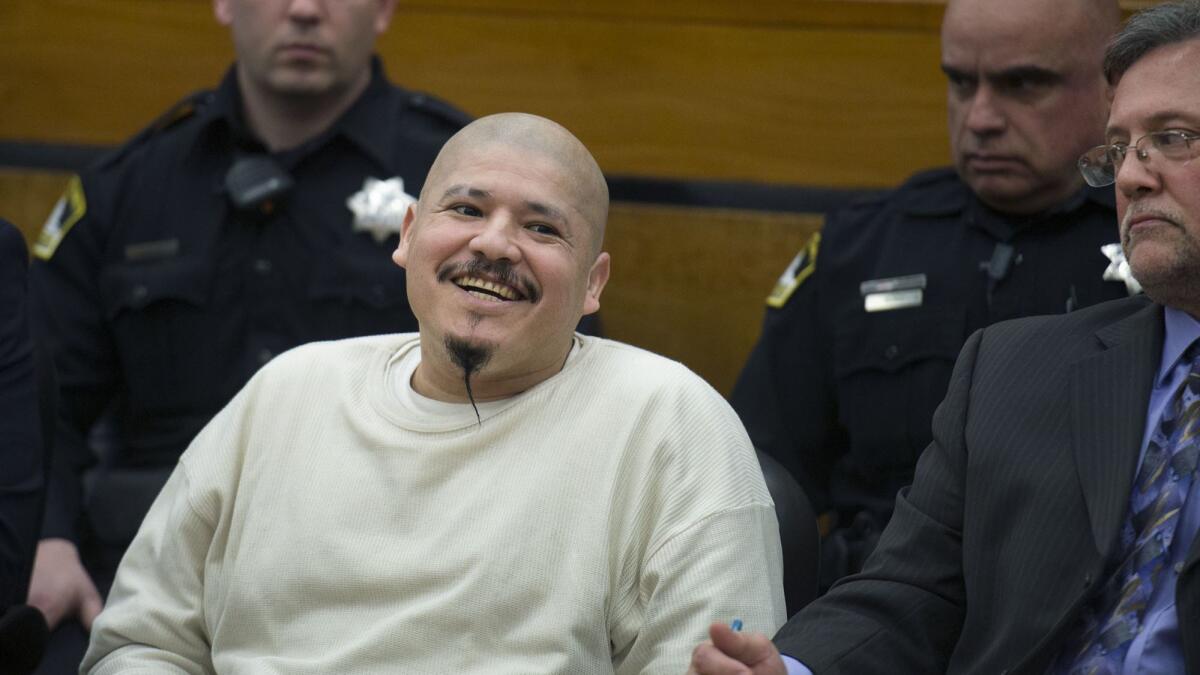Trump weaponizes immigration frenzy with killings, but crime data aren’t on his side

- Share via
They have been touted as the faces of illegal immigration, chilling examples of murderous men.
The remorseless cop-killer who smirked and swaggered in court. The gang member who shot a high school football star in the head. The homeless man who sent a bullet into the back of a young woman strolling along the pier.
Time and again, these three California cases have been hoisted and heralded by President Trump as the most lethal argument against immigration reform.
His diatribes have been met with waves of criticism by those who assert that Trump is scapegoating immigrants as a racist, fear-mongering tactic to influence voters.
The argument also runs in the face of numerous studies that say illegal immigration has been at historic lows over the last several years and that an overwhelming correlation exists between immigrants and low crime rates.
“As the undocumented population increases, the violent crime rate tends to go down. And we see this across the four main measures we think of with violent crime — robbery, rape, homicide and assault,” said Michael T. Light, a sociology professor at the University of Wisconsin who co-authored a study published in March.
Light noted that further research ruled out the possibility that those in the country illegally do not report violent crime.
“Very few homicides go unreported even if nobody is arrested,” he said. “This is a real decrease in crime, not a decrease in reporting.”
A study released this year by the Cato Institute, a libertarian public policy research organization, examined 2015 data from the Texas Department of Public Safety and found that homicide conviction rates for illegal and legal immigrants were 16% and 67% below those of native-born residents, respectively.
The Department of Homeland Security gauges trends in illegal immigration by looking at the number of people who are apprehended each year trying to cross the border. That figure climbed steadily from the 1970s through the 1990s, peaking at 1.64 million in 2000. This year it was 396,579 — lower than all but four of the previous 45 years.
But findings like these have never stopped Trump.
On Wednesday, the president encouraged constituents to “vote Republican now!” and tweeted a video of Luis Bracamontes, the man sentenced to death for killing two Northern California deputies while in the country illegally.
Bracamontes is seen grinning and vowing to kill more officers, while a message plays onscreen: “Democrats let him into our country. Democrats let him stay. Who else would Democrats let in?”
The footage was reminiscent of a 30-second ad that aired in January as part of Trump’s reelection campaign that featured Bracamontes and accused Democrats of being “complicit” in the slayings of law enforcement officers by people in the U.S. illegally.
With midterm elections just a few days away, Trump is trying to keep enthusiasm for the party high and excite his base by bringing the conversation back to immigration, said Louis DeSipio, professor of political science at UC Irvine.
“He can show his commitment to the values of the core of the Republican electorate by articulating a harsh, nationalistic, anti-immigrant message,” DeSipio said.
While the message doesn’t speak to moderates, it resonates with poor, white voters who live in rural areas. Places with smaller populations of immigrants tend to espouse some of the most strident policies against legal and illegal immigration, DeSipio said.
At the same time, Trump hedges when mass violence is conducted by white men, such as the Charlottesville, Va., nationalist rallies that ended in the death of Heather Heyer.
Trump argued there was blame on both sides and equated the actions of white nationalists, carrying Nazi flags and chanting “Jews will not replace us,” to those of counter-protesters.
“You had some very bad people in that group, but you also had people that were very fine people, on both sides,” Trump said shortly after the rallies.
Trump is unique compared with other politicians — such as former California Gov. Pete Wilson — who use anti-immigrant rhetoric and policies episodically. Trump does it with almost religious observance, steadily and passionately.
It’s a strategy he has employed since he was a presidential candidate, when he cited the death of Kathryn Steinle in San Francisco to make his case for building a wall across the U.S.-Mexico border.
“This senseless and totally preventable act of violence committed by an illegal immigrant is yet another example of why we must secure our border immediately,” Trump said in a statement two days after Steinle died in 2015. “This is an absolutely disgraceful situation, and I am the only one that can fix it.”
Jose Ines Garcia Zarate, a Mexican national who had been deported five times and was freed from custody under so-called sanctuary laws, was arrested on suspicion of Steinle’s murder. He argued that the weapon had accidentally gone off and that the bullet ricocheted, causing a tragic accident.
Defense attorneys who worked on the case said Trump made factual misrepresentations to further his agenda against immigration.
“We realized that the Trump rhetoric is very effective because what they’re after isn’t even whether someone is guilty,” said Matt Gonzalez, chief attorney with the San Francisco public defender’s office.
“They’re actually making a comment on causation to say, ‘This wouldn’t have happened if that person weren’t here.’ ”
That kind of argument is dangerous to a democracy, Gonzalez said.
“When you build a campaign based on drawing conclusions on who someone is instead of what they do, you attack the very fabric of what we’re supposed to be as a country,” he said.
When Garcia Zarate was acquitted last year, Trump tweeted, “A disgraceful verdict in the Kate Steinle case! No wonder the people of our Country are so angry with Illegal Immigration.”
The politicization didn’t go unnoticed by Steinle’s family.
“For Donald Trump, we were just what he needed — beautiful girl, San Francisco, illegal immigrant, arrested a million times, a violent crime and yadda, yadda, yadda,” Liz Sullivan, Steinle’s mother, told the San Francisco Chronicle.
“We were the perfect storm for that man.”
But the father of a 17-year-old fatally shot on his way to his Los Angeles home has embraced Trump’s ideology in which illegal immigration is connected to violence.
Gang member Pedro Espinoza was in the country illegally when he shot Jamiel Shaw II twice on a spring night in 2008. Espinoza had been freed from jail two days earlier without immigration authorities placing a hold on him. He was convicted of first-degree murder four years later and sentenced to death for Shaw’s slaying.
Shaw’s father, also named Jamiel, has repeatedly aligned himself with Trump — whom he calls his “friend” — especially over issues related to immigration.
He spoke at the Republican National Convention in 2016 for the then-presidential candidate.
Trump was “sent by God,” Jamiel Shaw Sr. proclaimed.
“Only Trump will stand against terrorists and end illegal immigration,” he said to applause. “Build the wall.”
Twitter: @thecindycarcamo
Twitter: @hannahnfry
Twitter: @corinaknoll
More to Read
Sign up for Essential California
The most important California stories and recommendations in your inbox every morning.
You may occasionally receive promotional content from the Los Angeles Times.













